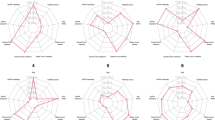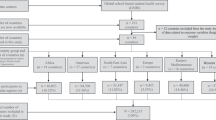Abstract
Background/Objective:
Our objective was to investigate whether school lunch attendance was associated with overall eating habits and sedentary behaviour in a French sample of children and adolescents.
Subjects/Methods:
Data for the study were taken from the second French cross-sectional dietary survey (INCA2-2006-07). In total, 1413 school children aged 3–17 years old were classified according to their school type and their usual school lunch attendance. Eating habits included meal regularity, dietary diversity, purchase in vending machine, snacking habits and frequency of eating in fast-foods. Two composite indices of eating habits were derived from multiple correspondence analyses. Sedentary behaviour was assessed by the average daily screen times for TV and computer. The association between school lunch attendance and each variable was tested. Multivariate association between school lunch attendance and the composite indices of eating habits and sedentary behaviours was studied.
Results:
In all, 69.0% (CI95%: 64.2–73.9) of secondary school children and 63.0% (CI95%: 58.5–67.5) of pre- and elementary school children usually attended school lunch at least once a week. Pre- and elementary school children attending school lunches showed a higher dietary diversity score (P=0.02) and ate morning snacks more frequently (P=0.02). In secondary school children, attending school canteen was related to a lower rate of skipping breakfast (P=0.04) and main meals (P=0.01). In all school children, school lunch attendance was simultaneously associated with healthier overall eating habits and less sedentary behaviour.
Conclusion:
In France, children attending school canteens seem to have healthier eating habits and display less sedentary behaviour, independently of their socio-economic and demographic background.
This is a preview of subscription content, access via your institution
Access options
Subscribe to this journal
Receive 12 print issues and online access
$259.00 per year
only $21.58 per issue
Buy this article
- Purchase on Springer Link
- Instant access to full article PDF
Prices may be subject to local taxes which are calculated during checkout
Similar content being viewed by others

References
WHO. Diet, Nutrition and the prevention of chronic diseases 2003.
Programme national nutrition santé 2001–2005. Ministère de l'Emploi et de la solidarité - Ministère délégué à la Santé, Janvier 2001. Available from http://www.sante.gouv.fr/IMG/pdf/version_anglaise.pdf.
Deuxième Programme national nutrition santé 2006–2010. Ministère de la Santé et des Solidarités, Septembre 2006. Available from http://www.sante.gouv.fr/IMG/pdf/pnns2.pdf.
Programme National Nutrition Santé 2011–2015. Ministère du Travail, de l’Emploi et de la Santé, Juillet 2011. Available from http://www.sante.gouv.fr/IMG/pdf/French_National_Nutrition_and_Health_Program_2011-2015.pdf.
Lien N, Lytle LA, Klepp KI . Stability in consumption of fruit, vegetables, and sugary foods in a cohort from age 14 to age 21. Prev Med 2001; 33: 217–226.
Nicklaus S, Boggio V, Chabanet C, Issanchou S . A prospective study of food variety seeking in childhood, adolescence and early adult life. Appetite 2005; 44: 289–297.
Basdevant A, Boute D, Borys JM . Who should be educated? Education strategies: could children educate their parents? Int J Obes Relat Metab Disord 1999; 23 (Suppl 4), S10–S12. ; discussion S12-S13.
Borys JM, Lafay L . L’information nutritionnelle des enfants pour modifier les habitudes alimentaires de toute la famille. Rev Méd Suisse Romande 2000; 120: 207–209.
Story M, Nanney MS, Schwartz MB . Schools and obesity prevention: creating school environments and policies to promote healthy eating and physical activity. Milbank Q 2009; 87: 71–100.
Circulaire DESCO B4 n°2004-095 du 25 mars 2004. « Collation matinale à l’école », (25 mars 2004, 2004). Available from http://media.eduscol.education.fr/file/Action_sanitaire_et_sociale/36/4/note-collation-25-03-04_116364.pdf.
Loi n°2004-806 du 9 août 2004 relative à la politique de santé publique, Pub. L. No. 2004-806(9 août 2004, 2004). Available from http://www.legifrance.gouv.fr/jopdf/common/jo_pdf.jsp?numJO=0&dateJO=20040811&numTexte=4&pageDebut=14277&pageFin=14337.
Décret no 2011-1227 du 30 septembre 2011 relatif à la qualité nutritionnelle des repas servis dans le cadre de la restauration scolaire.
Arrêté du 30 septembre 2011 relatif à la qualité nutritionnelle des repas servis dans le cadre de la restauration scolaire.
Larson N, Story M . A review of environmental influences on food choices. Ann Behav Med 2009; 38 (Suppl 1), S56–S73.
Lafay L, Volatier J-L, Martin A . La restauration scolaire dans l'enquête INCA - Associations entre facteurs socio-démographiques, mode de vie et fréquentation de la restauration scolaire (1ère partie). Cah Nutr Diét 2002; 37: 36–44.
Lioret S, Dubuisson C, Dufour A, Touvier M, Calamassi-Tran G, Maire B et al. Trends in food intake in French children from 1999 to 2007: results from the INCA (etude Individuelle Nationale des Consommations Alimentaires) dietary surveys. Br J Nutr 2010; 103: 585–601.
Dufour A, Lafay L, Volatier J-L . La mesure des consommations alimentaires par l'enquête INCA2. In: Dunod, (eds). Méthodeqs de sondage. Paris, 2008 132–138.
Dubuisson C, Lioret S, Touvier M, Dufour A, Calamassi-Tran G, Volatier JL et al. Trends in food and nutritional intakes of French adults from 1999 to 2007: results from the INCA surveys. Br J Nutr 2010; 103: 1035–1048.
Dubuisson C, Lioret S, Dufour A, Calamassi-Tran G, Volatier J-L, Lafay L et al. Socio-economic and demographic variations in school lunch participation of French children aged 3-17 years. Public Health Nutr 2011; 14: 227–238.
Kant AK, Block G, Schatzkin A, Ziegler RG, Nestle M . Dietary diversity in the US population, NHANES II, 1976-1980. J Am Diet Assoc 1991; 91: 1526–1531.
INPES. Le guide nutrition des enfants et ados pour tous les parents - La santé vient en mangeant et en bougeant. Programme National Nutrition Santé (ed). 2004 Available from: http://www.inpes.sante.fr/CFESBases/catalogue/pdf/688.pdf.
Macdiarmid J, Loe J, Craig LC, Masson LF, Holmes B, McNeill G . Meal and snacking patterns of school-aged children in Scotland. Eur J Clin Nutr 2009; 63: 1297–1304.
Lafay L, Volatier J-L, Martin A . La restauration scolaire dans l'enquête INCA - Les repas servis en restauration scolaire: apports nutritionnels, alimentaires et impact sur la nutrition des enfants. Cah Nutr Diét 2002; 37: 395–404.
Falciglia GA, Troyer AG, Couch SC . Dietary variety increases as a function of time and influences diet quality in children. J Nutr Educ Behav 2004; 36: 77–83.
Steyn NP, Nel JH, Nantel G, Kennedy G, Labadarios D . Food variety and dietary diversity scores in children: are they good indicators of dietary adequacy? Public Health Nutr 2006; 9: 644–650.
CLCV/DGAL. Etude relative à la perception et aux attentes des parents et enfants concernant la restauration scolaire. Direction Générale de l'Alimentation, Septembre 2009. Available from: http://agriculture.gouv.fr/IMG/pdf/091215_rapport_final_CLCV-resto_scol__sans_annexe_.pdf.
Nelson M, Lowes K, Hwang V . The contribution of school meals to food consumption and nutrient intakes of young people aged 4-18 years in England. Public Health Nutr 2007; 10: 652–662.
Kubik MY, Lytle LA, Hannan PJ, Perry CL, Story M . The association of the school food environment with dietary behaviors of young adolescents. Am J Public Health 2003; 93: 1168–1173.
Templeton SB, Marlette MA, Panemangalore M . Competitive foods increase the intake of energy and decrease the intake of certain nutrients by adolescents consuming school lunch. J Am Diet Assoc 2005; 105: 215–220.
Wardle J, Herrera ML, Cooke L, Gibson EL . Modifying children's food preferences: the effects of exposure and reward on acceptance of an unfamiliar vegetable. Eur J Clin Nutr 2003; 57: 341–348.
Remington A, Anez E, Croker H, Wardle J, Cooke L . Increasing food acceptance in the home setting: a randomized controlled trial of parent-administered taste exposure with incentives. Am J Clin Nutr 2012; 95: 72–77.
Cooke L, Carnell S, Wardle J . Food neophobia and mealtime food consumption in 4-5 year old children. Int J Behav Nutr Phys Act 2006; 3: 14.
Perez-Rodrigo C, Ribas L, Serra-Majem L, Aranceta J . Food preferences of Spanish children and young people: the enKid study. Eur J Clin Nutr 2003; 57 (Suppl 1), S45–S48.
Gosliner W, Madsen KA, Woodward-Lopez G, Crawford PB . Would students prefer to eat healthier foods at school? J Sch Health 2011; 81: 146–151.
Rampersaud GC, Pereira MA, Girard BL, Adams J, Metzl JD . Breakfast habits, nutritional status, body weight, and academic performance in children and adolescents. J Am Diet Assoc 2005; 105: 743–760.
Pedersen TP, Meilstrup C, Holstein BE, Rasmussen M . Fruit and vegetable intake is associated with frequency of breakfast, lunch and evening meal: cross-sectional study of 11-, 13-, and 15-year-olds. Int J Behav Nutr Phys Act 2012; 9: 9.
Tin SP, Ho SY, Mak KH, Wan KL, Lam TH . Lifestyle and socioeconomic correlates of breakfast skipping in Hong Kong primary 4 schoolchildren. Prev Med 2011; 52: 250–253.
Lioret S, Touvier M, Lafay L, Volatier JL, Maire B . Dietary and physical activity patterns in French children are related to overweight and socioeconomic status. J Nutr 2008; 138: 101–107.
Tin SP, Ho SY, Mak KH, Wan KL, Lam TH . Breakfast skipping and change in body mass index in young children. Int J Obes (Lond) 2011; 35: 899–906.
Lehto R, Ray C, Lahti-Koski M, Roos E . Meal pattern and BMI in 9-11-year-old children in Finland. Public Health Nutr 2011; 14: 1245–1250.
AFSSA. Etude Individuelle Nationale des Consommations Alimentaires 2 (INCA 2) (2006-2007). Février 2009. Available from: http://www.anses.fr/Documents/PASER-Ra-INCA2.pdf.
Lafay L, Bocle J-C, Kalonji E, Berta J-L, Martin A . La collation matinale: fréquence, composition alimentaire et impact sur la nutrition des enfants. Cah Nutr Diét 2004; 39: 401–408.
Utter J, Scragg R, Schaaf D . Associations between television viewing and consumption of commonly advertised foods among New Zealand children and young adolescents. Public Health Nutr 2006; 9: 606–612.
Vereecken CA, Maes L . Television viewing and food consumption in Flemish adolescents in Belgium. Soz Praventivmed 2006; 51: 311–317.
Vereecken CA, Todd J, Roberts C, Mulvihill C, Maes L . Television viewing behaviour and associations with food habits in different countries. Public Health Nutr 2006; 9: 244–250.
Lioret S, Maire B, Volatier JL, Charles MA . Child overweight in France and its relationship with physical activity, sedentary behaviour and socioeconomic status. Eur J Clin Nutr 2007; 61: 509–516.
Tremblay MS, LeBlanc AG, Kho ME, Saunders TJ, Larouche R, Colley RC et al. Systematic review of sedentary behaviour and health indicators in school-aged children and youth. Int J Behav Nutr Phys Act 2011; 8: 98.
Acknowledgements
INCA2 was supported by a grant from the French Food Safety Agency (AFSSA), now ANSES.
Author information
Authors and Affiliations
Corresponding author
Ethics declarations
Competing interests
The authors declare no conflict of interest.
Additional information
Contributors: CD analysed the data and wrote the paper. LL, SL, J-LV and DT helped to write the paper. CD, AD, LL, SL, and J-LV contributed to the design and data collection of the INCA2 survey. All the authors reviewed the manuscript.
Rights and permissions
About this article
Cite this article
Dubuisson, C., Lioret, S., Dufour, A. et al. Associations between usual school lunch attendance and eating habits and sedentary behaviour in French children and adolescents. Eur J Clin Nutr 66, 1335–1341 (2012). https://doi.org/10.1038/ejcn.2012.137
Received:
Revised:
Accepted:
Published:
Issue Date:
DOI: https://doi.org/10.1038/ejcn.2012.137
Keywords
This article is cited by
-
Number of meal components, nutritional guidelines, vegetarian meals, avoiding ruminant meat: what is the best trade-off for improving school meal sustainability?
European Journal of Nutrition (2022)
-
Early life determinants of dietary patterns in preschool children: Rhea mother–child cohort, Crete, Greece
European Journal of Clinical Nutrition (2016)


